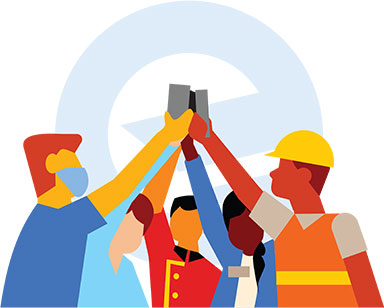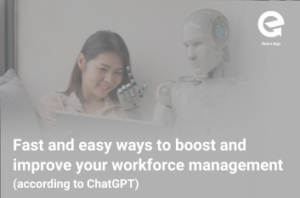Workforce management tools can be deployed enterprise-wide and through mobile cloud platforms allowing employees to access these tools on their personal mobile devices. Numerous functional areas use these tools, including HCM (human capital management), ERP (enterprise resource planning), SLM (service lifecycle management), CRM (customer relationship management), and HR (human resources). These tools vary by size of the company, industry, and the unique composition of a workforce. A company with many non-desk workers requires a different workforce management toolset than a company made up of desk-bound employees. Regardless of size or need, these tools are designed to help managers cultivate an ideal work environment for everyone, which results in a more prosperous company.
Workforce management tools consist of software, apps, and platforms that increase employees’ overall efficiency and productivity—matching the right employee, to the right job at the right time while allowing management to oversee and measure employee operations effectively. Companies with large and spread-out non-desk workforces turn to these tools to help create long-distance collaboration, employee engagement, a culture of shared values and goals, remote resource management, and effective productivity tracking.
What are the different types of workforce management tools?
Workforce management tools are performance-based tools to support corporate management, front-line supervisors, managers, and non-desk workers across manufacturing, distribution, transportation, hospitality, and healthcare. These tools help manage payroll, benefits, talent management, onboarding, training, workforce management, time and labor management, learning, communication, employee engagement, rewards and recognition, culture, surveys, scheduling, forecasting, budgeting, and employee performance. With these workforce management tools, companies and management can make data-driven decisions to improve productivity and profitability.

How do you choose the best workforce management tools?
According to Forbes the best workforce management tools vary by industry, employees, culture and much more. Remember that what you may think is the best tool may not be adopted by the employees and therefore isn’t the best choice. The best option is the tool that is used, and that one is adopted by your workforce and seen as an essential aid to them doing their job and improving their work-life. Adoption is significant, but usage is where the power of your workforce management tools see their most important benefit.
Providing a workforce management tool used by your desk-bound workforce but ignored by your non-desk workforce can mean that you are missing out on millions of dollars in profits. Recent research has shown that for every 1000 employees, workforce management tools can save companies up to $8 million a year, with time savings alone projected to save over $1000 per employee.
With almost all workforce management tool companies offering FREE trials, the risk of choosing the wrong tool has been dramatically reduced. Choose a team, a location, or department and test the product, look for ease of use, adoption, and usage rates. Most companies like Red e App will offer customer success managers to ensure you get the most value out of their product.
Workforce management tool applications.
Workforce management tools help companies improve, plan, manage, track employee performance and measure workforce efficiency. They also enable managing paid time off, employee schedules, and compliance with local and federal labor requirements. Many workforce management tools are implemented in HR departments, though businesses use some products without a traditional HR department. Many of these tools are available as a self-serve option that enables employees to check PTO balances, request days off, pickup, and trade shifts.
These workforce management tools can be implemented either as an integrated HR management suite or as a standalone solution. Many of these tools integrate with third-party HR applications, with a core HR system or centralized hub providing a repository for workforce data.
How do workforce management tools work in a mix?
Many workforce management tools are designed to work together. Some provide extended life and value to legacy systems. A few like Red e App can even improve employee usage across other HCM products like employee reward and recognition platforms. With non-desk employees, we have consistently seen much higher use when employees have one centralized hub to access all these tools. What works in a desk-based work environment doesn’t translate to a highly mobile workforce; employee engagement and usage must be easy, centralized, and viewed as a tool to benefit them first and foremost, not the company.

What kind of issues can workforce management tools resolve?
Employees are the lifeblood of your company; when you have the right tools in place, employees can do their best work. Here is a list of just some of the workplace issues that workforce management tools resolve:
- Business process analysis tracks what computer applications are being used and which aren’t, allowing companies to eliminate programs with disrupting workflow.
- Increased security, by tracking employee behaviors, management can determine when or where a data breach may have occurred.
- Real-time communications.
- Helps with scheduling during peak times.
- Manage seasonal workers.
- Track skills of employees have been acquired for future promotions.
- Create communication across the entire workforce.
- Keep HR needs from getting away from you.
- Track timeliness and attendance trends.
- Adjust schedule to staffing needs.
- Turn your dead data into live data.
- Recruitment tools.
- Performance ratings.
- One central hub for all HCM applications.
- Manage multiple departments.
- Prevents silos of disconnected employees.
- Provides non-desk employees access to the same information as desk-bound workers.
- Integrates with payroll.
- Workforce motivation and morale.
- Forecasting of staffing, predicting schedules and productivity levels.
- Budgeting, where a reallocation of company resources may be needed.
- Manage and track leaves, vacation, and COVID-19 staffing.
- Time clocks, keep track of your employee’s attendance and time worked.
- Payroll, a central location for confidential information like direct deposit details and insurance policies.
- Safety guidance.
- COVID-19 alerts and employee health.
- Highly structured communications making sure the right message gets to the right person at the right time.
- Observe all relevant legislations, local agreements, and contracts of individual employees.
- Ensure compliance with all local and national requirements.
- Analyze historical data and forecast staffing needs.
- Identify skill shortages and maintain skill levels.
- Allow workers to pick-up overtime and trade shifts.
- Maintain a level playing field for overtime access.
- Track employee compliance.
- Track company-wide communications.
- Measure effectiveness of manager communications.
- Benefit management.
- Compliance issues.
- See who is working on what part of a project.
- A visual team planner.
- Measure project progression.
- Allow roles to be created for team members.
- Improved employee retention.
- Boosted employee morale.
- Increased employee productivity.
- Enhanced customer service.
- Improved product quality.
- Employees feel appreciated and part of the company.
- Transparency allows employees to feel engaged and trusted.
- Team communication transforms a group of individuals into a powerhouse.
- Leaders communicate, the great ones become Red e Champs.
- Analytics provides reporting to improve efficiency.
- Real-time updating of employee access and structure, platforms like Shelbe AI, provide intuitive learning which allows your employee permissions to be up-to-date and in compliance.
What is the cost of a workforce management tool?
There are many tools to choose from; my recommendation is to start with a product used in your industry. Ask to talk to several of the customers of the workforce management tool provider. Find out what they say about implementation, adoption, usage, and hidden or extra costs. Ensure that your workforce aligns with these people you are talking to, how big their non-desk workforce is, what existing solutions they had before bringing on other tools.
Compare products, pricing for a self-serve solution starts for as little as $2.00 per employee, more complex needs requiring lots of forms or customer support can be found for $5 per employee, and enterprise solutions with lots of customization start around $5 to $8 per employee. Remember to request reports showing the usage rates and ROI, follow up on these to verify actual numbers, and don’t be fooled by adoption rates imposed on employees or usage rates that don’t show multiple weekly uses of a product.
If you have any questions, please don’t hesitate to reach out to sales@redeapp.com or 855-733-3277, or if you would like a personal demo of the Red e App workforce management tool, I would love to walk you through what has been called the world’s best employee engagement tool for non-desk workforces. It all begins with communication; it costs you money, productivity, and employee retention if you aren’t communicating with your non-desk employees.
Jim White
Communications Director
Red e App


